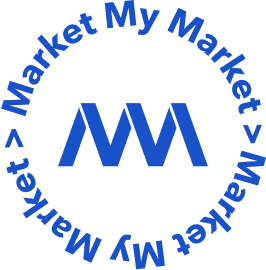Written by Market My Market’s content team, with contributions from Jordan Kimmel, Lindsay Bennett, Kenzie Fox, and Kelly Quintana
The concept of StoryBranding—a process designed to help us understand brands the same way stories help us know characters—is a powerful and harnessable instrument in our creative toolbelts. The general idea behind StoryBranding is that if you can clarify your message, you can better communicate your value, connect with your audience, and grow your business. By using the StoryBrand 7-part framework—a researched storytelling technique that follows an easy-to-understand blueprint—you may be able to better tap into your customer’s wants and needs and put your client and their concerns at the center of your brand.
The StoryBrand 7-part framework, in simple terms, is a structure that includes your customer, a problem they need to solve, your business, your solutions, a call-to-action to start the buying process, and ultimately a successful outcome that helps them avoid failure. If you can effectively follow this studied model, your brand has a better chance of successfully reaching its audience. Here’s what you need to know.
Contributed by Jordan Kimmel, Content Lead
The 7 Categories of StoryBranding
Stories are a powerful and memorable way to reach an audience. All great stories, such as the Hobbit or the Odyssey, follow a tried and true framework known as the Hero’s Journey. Fortunately, the StoryBrand method follows its own seven-part framework to help you engage your audience, simplify your message, and tell your brand’s story using the following steps:
The Character
First, your story needs a main character with whom your audience can connect. Your main character should represent your customer or client and be the hero of your story. On the other hand, you and your business will act as the hero’s guide. Your character’s needs and motivations should be directly in line with your clients and customers so they can see themselves in the character’s shoes.
The Problem
Your hero must face an obstacle they must overcome to reach their goals. Ask yourself why your client would seek your services. Have they been injured in an accident and need legal representation? Are they moving offices and need a logistics partner? Asking and answering these questions can help you determine the problem your hero faces.
The Guide
Typically, clients and customers are not looking for a hero but a guide to help them with their problems. Presenting your firm as a helpful guide who can assist in achieving the hero’s goals can help build trust with your clients and customers. A good guide presents themselves as empathetic to the hero and authoritative in their industry knowledge.
The Plan
The guide then provides the hero with a blueprint detailing how to overcome their problem and reach their goals. While plans can have several smaller steps, they are typically divided into three sections:
- Scheduling an appointment to discuss the problem
- Allowing the guide to create a plan to fit the hero’s unique needs
- Leading the hero through every step of the execution phase
Breaking the plan down into these essential elements can make it easier for potential clients to visualize, making them more likely to pick up the phone.
The Call to Action
After laying the groundwork, it’s time to ask your potential client to take the next step, whether that entails calling to schedule a free consultation or filling out your online contact form. Be clear and direct in your call to action so the reader knows exactly what to do.
The Potential for Failure
A story without stakes or conflict is not an interesting one. What are the potential consequences if the hero does not choose you as their guide? Remind the reader success is only possible with your experienced guidance.
The Successful Outcome
Highlight what will be gained from taking the next step in the process. How does the hero come out on top? To ensure your story flows and ties together, make sure the successful outcome is directly related to the initial problem.
Contributed by Lindsay Bennett, Content Writer
How StoryBranding Can Effectively Market to Potential Clients
The goal of a solid marketing campaign is to promote and encourage consumers to invest in the company and its products/services. StoryBranding highlights the consumer rather than the product and places emphasis on a clear, digestible message.
While providing consumers with factual information and statistics may showcase the qualities of the product, it fails to captivate and convince the audience that purchasing the product or service will assist their goals and resolve their conflict. StoryBranding, however, utilizes a narrative structure and immerses consumers in a situation aimed to portray how the company can turn their dreams into reality.
StoryBrand’s ability to increase a marketing message’s clarity is a major benefit of using this strategy. Without a fully developed brand message, a company will fail to reach its target audience. The simple fact is that StoryBranding is purposeful, engaging, and action-oriented. Through a viable problem-solution outline, companies are able to attract consumers to their products and services.
Contributed by Kenzie Fox, Content Specialist
Take Client Outreach to the Next Level with Market My Market
Take advantage of the opportunity to transform your marketing approach and propel your business forward. Implementing the StoryBrand 7-Part Framework can revolutionize your client communication strategy and help you effectively reach your target audience. By illuminating your message, identifying your client’s needs, and crafting compelling narratives, you can create a powerful connection that resonates with your clients and drives results.
Ready to take your client outreach to the next level? Contact Market My Market today and let our team of experts help you implement the StoryBrand 7-Part Framework. With our expertise and tailored strategies, we’ll help you create a captivating brand story that captivates your clients and drives conversions. Reach out today by completing our online contact form or calling (866) 270-2250.
Contributed by Kelly Quintana, Content Writer


